Discover the Fascinating World of Woodpeckers in Indiana
Updated: 13 Mar 2024
48
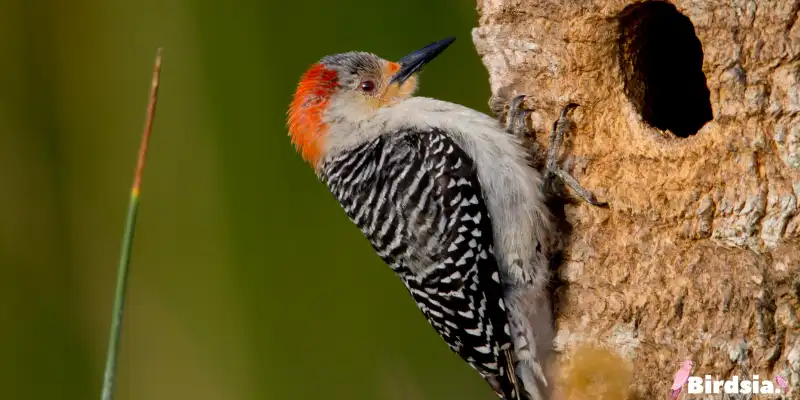
Indiana is home to a diverse array of woodpecker species, with a total of 7 identified within its borders. Among the approximately 300 species of woodpeckers worldwide, about 17 are native to the United States. This makes Indiana a significant hub for these distinctive birds, contributing to the state’s rich avian biodiversity.
This article focuses on Indiana woodpeckers, providing pictures for identification, details about their size and appearance, brief descriptions with interesting facts, and information on where and how to find them in the state of Indiana.
Here is a list of the 7 types of woodpeckers found in Indiana:
1. Downy Woodpecker:
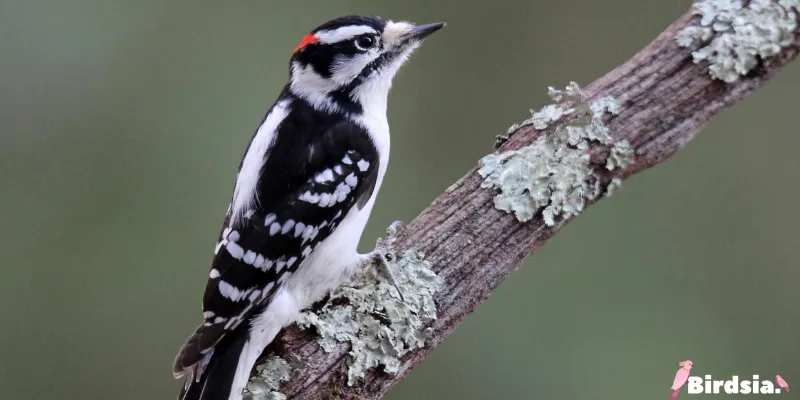
Downy Woodpeckers, the smallest woodpeckers in North America, are a common sight year-round in Indiana. They can be found throughout Indiana, including both rural and urban areas. Known for their fondness for bird feeders, they enjoy various foods like suet, peanuts, mixed seeds, or black sunflower seeds.
Often, Downy Woodpeckers are among the first visitors to new feeders, usually accompanied by chickadees and titmice. Unlike migratory species, they don’t migrate long distances and remain active even in winter.
Apart from feeder visits, they forage by pecking at trees for insects, feeding on berries and acorns, and sometimes even drinking nectar from hummingbird feeders. For nesting, they prefer dead trees or branches, where they create cozy cavities to raise their young.
Identifying Characteristics:
- It is relatively small in size with a small bill compared to other woodpecker species.
- White bellies contrast with mostly black backs, exhibiting streaks and spots of white.
- Male birds feature a distinctive red spot on the back of their heads, absent in females.
Measurement of the Downy Woodpecker (Picoides pubescens):
- Length: Between 5.5 and 6.7 inches
- Weight: Ranging from 0.7 to 1.0 ounces
- Wingspan: Spanning between 9.8 and 11.8 inches
2. Hairy Woodpecker (Picoides villosus):
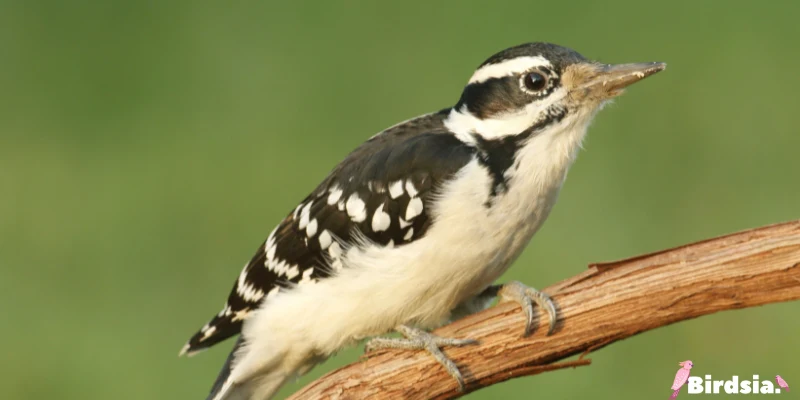
The Hairy Woodpecker, found year-round in Indiana, closely resembles the Downy Woodpecker, making them challenging to differentiate due to their similar appearance. Here are three key ways to distinguish between them:
- Size:
- Hairy Woodpeckers are larger, measuring 9–11 inches (23–29 cm) long, similar in size to an American Robin.
- Downy Woodpeckers are smaller, measuring 6–7 inches (15–18 cm) long, slightly larger than a House Sparrow.
- Bill:
- Downy Woodpeckers have a tiny bill, measuring less than half the length of their heads.
- Hairy Woodpeckers have a bill nearly the same length as their heads.
Outer tail feathers:
- Hairy Woodpeckers have completely white outer tail feathers.
- Downy Woodpeckers have spotted outer tail feathers.
Lastly, to identify a Hairy Woodpecker by sound, listen for its distinct calls:
- The most common call is a short, sharp “peek,” which is slightly lower in pitch compared to a Downy Woodpecker’s call.
- They also produce a sharp rattling or whinny sound.
These characteristics can help birdwatchers accurately identify these woodpecker species.
3. Red-Headed Woodpecker:

In Indiana, you might catch sight of Red-headed Woodpeckers all year round. Although they don’t visit bird feeders as much as other woodpeckers, they do drop by occasionally to grab some food and stash it away in tree holes for later.
These woodpeckers mostly eat bugs like beetles, along with seeds and berries. They’re pretty good at catching bugs mid-flight, which helps them stay well-fed in the woods. One cool thing about them is that they store live bugs in tree bark for later snacks.
But even though they’re awesome birds, their numbers have been going down lately. That means you might not see them as much as you used to. It’s really important to protect their homes and help them out so they can keep hanging around in Indiana’s forests.
Identifying Characteristics:
- Large red head and bill are larger than most other woodpecker species.
- Entirely black back with white wing patches, contrasting against the pure white belly.
Measurement of the Red-Headed Woodpecker (Melanerpes erythrocephalus):
- Length: 7.5–9.1 inches
- Weight: 2.0-3.2 ounces
- Wingspan: 16.5 inches
4. Red-Bellied Woodpecker:
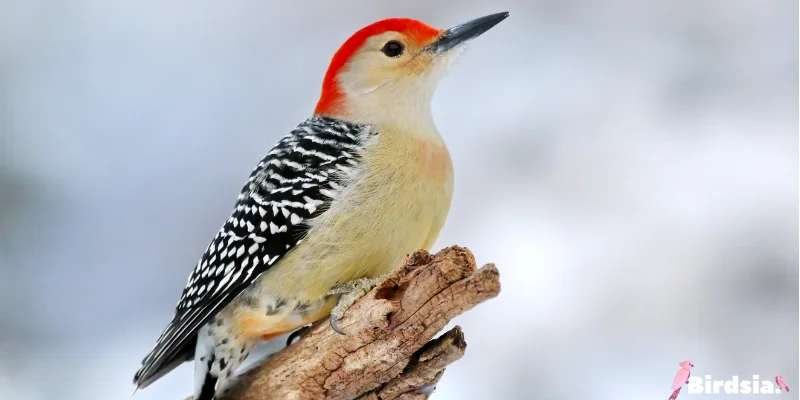
In Indiana, you can spot Red-bellied Woodpeckers all year round. These woodpeckers are bigger than Downy Woodpeckers but about the same size as Hairy Woodpeckers. They love visiting bird feeders, especially ones with suet.
Even though they’re called Red-bellied Woodpeckers, the most eye-catching part about them is their bright red heads. But don’t get them confused with Red-headed Woodpeckers at first glance. When you look closer, you’ll notice some key differences.
While they do have a bit of red on their bellies, it’s usually a lighter shade that might not stand out right away, especially against a tree or feeder. Instead, their unique black and white wings and the red “mohawk” down their neck are better clues for telling them apart from other woodpeckers.
Identifying Characteristics:
- Males exhibit bright red plumage extending from their bills to the back of their necks, while females have red only on the back of their necks.
- Undersides display a mixture of white and tan.
- Backs feature a black and white barred pattern.
Measurement of the Red-Bellied Woodpecker (Melanerpes carolinus):
- Length: 9.4 inches
- Weight: Ranging from 2.0 to 3.2 ounces
- Wingspan: Spanning between 13.0 and 16.5 inches
5. Pileated Woodpecker:

Pileated Woodpeckers are big birds you can see all year in most of Indiana, but not so much in the northeast. They’re the biggest woodpeckers around and look cool.
They like hanging out at suet feeders, just like other woodpeckers, but they’re a bit shy. Even bird lovers might need help getting them to visit their backyard feeders.
These woodpeckers love old, dead trees, which are important for forests. If you have those trees around, you might see more Pileated Woodpeckers. Putting up nest boxes can also help attract them to your yard.
For nesting, they like big trees in older forests. They use their strong beaks to make big holes in trees for their nests. They mostly eat carpenter ants, but they also enjoy beetle larvae, termites, bugs, and sometimes fruits and nuts.
Identifying Characteristics:
- Mostly black plumage with white stripes on the face and neck.
- Search for a large, triangular red crest atop their heads.
- Males feature a red stripe on their cheeks, while females have a black stripe in the same area.
Measurement of Pileated Woodpecker (Dryocopus pileatus):
- Length: 15.8–19.3 inches
- Weight: 8.8–12.3 ounces
- Wingspan: 26.0–29.5 inches
6. Yellow-Bellied Sapsucker:

Yellow-bellied Sapsuckers aren’t regulars at bird feeders, but they might show up at suet feeders sometimes. Most of the time, though, you’ll see them hanging out on tree branches, looking for bugs or drinking sap. They’re famous for drilling holes in birch and maple trees to get the sap with their long tongues.
Even though they’re called Yellow-bellied Sapsuckers, their bellies aren’t really bright yellow. They’ve got black and white feathers with cool markings. They’re about the size of a Robin and you can find them all over Indiana.
In the winter, they’re mostly in southern Indiana. But in spring, they head north through northern Indiana to breed in places like Michigan and even Canada. It shows how they can adapt to different places and how important it is for them to have the right habitats to live in and raise their babies.
Identifying Characteristics:
- They sport a black and white backside with a prominent white shoulder patch.
- Spot their distinct red crowns and striped black and white faces. Males showcase a red throat, while females display white!
- True to their name, most individuals exhibit a yellowish-white belly.
Measurement of Yellow-bellied Sapsucker (Sphyrapicus varius):
- Length: 7.1–8.7 inches
- Weight: 1.5–1.9 ounces
- Wingspan: 13.4–15.8 inches
7. Northern Flicker
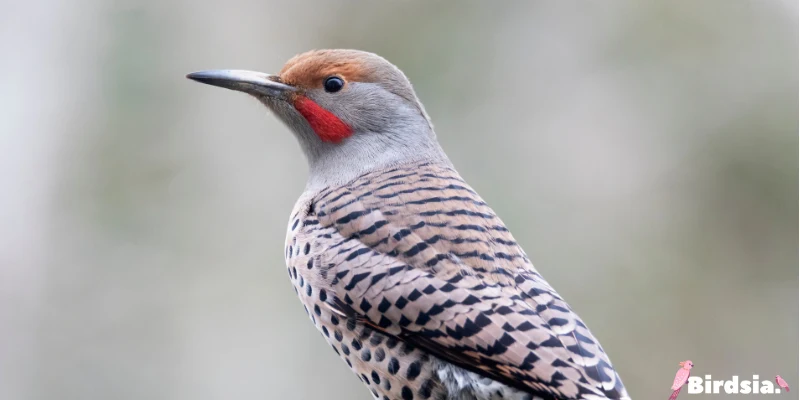
Northern Flickers are pretty common in Indiana all year round, and you’ll often see them in backyards and suburbs. While they might drop by feeders now and then, they mostly dine on ants, which they pick up from the ground by poking through leaves and dirt with their long tongues.
Besides ants, Northern Flickers eat other bugs, berries, sunflower seeds, and thistles. Even though they’re ground feeders, they like to drum on trees to communicate with each other, which is pretty cool.
These woodpeckers like to make their nests in old or rotting trees, just like other woodpeckers. You can tell them apart by their spotted bellies, black bibs, red patches on their necks, and yellow tail feathers. They’re bigger than Hairy Woodpeckers but smaller than Pileated Woodpeckers. With their flashy looks and interesting habits, they’re a neat part of Indiana’s bird community.
Identifying Characteristics:
- Size comparable to an American Robin
- Black bib and spotted belly
- Yellow feathers under wings and tail are visible in flight
- Male has a black mustache stripe.
Measurement of Northern Flickers (Colaptes auratus):
- Length: 11.0–12.2 inches
- Weight: 3.9-5.6 ounces
- Wingspan: 16.5-20.1 inches
Final Thought:
In conclusion, Indiana is home to a diverse and fascinating array of woodpecker species, each with its own unique characteristics and behaviors. From the tiny Downy Woodpecker to the majestic Pileated Woodpecker, these birds play important roles in Indiana’s ecosystems, from controlling insect populations to contributing to forest health.
Birdwatchers and nature enthusiasts in Indiana have the opportunity to observe and appreciate these woodpeckers throughout the year, whether in backyards, suburban areas, or natural habitats. By providing suitable habitats, such as old trees and nest boxes, and supporting conservation efforts, individuals can help ensure the continued presence of these captivating birds in Indiana’s landscapes.
Understanding and appreciating the rich diversity of woodpeckers in Indiana not only enriches our connection with nature but also underscores the importance of conservation efforts to protect and preserve our natural heritage for future generations to enjoy.
What is the most common woodpecker in Indiana?
The Downy Woodpecker (Picoides pubescens) is the most common woodpecker species in Indiana.
Are woodpeckers protected in Indiana?
Those who offer public services or charge for nuisance wild animal control services must pass a test and pay a $25.00 fee for the permit. However, it’s important to note that federally protected migratory birds, such as Canada geese and woodpeckers, cannot be targeted or removed under the authority of this permit.
Do Indiana woodpeckers migrate?
Indiana hosts seven out of the 28 woodpecker species found in North America. Most of these species are year-round residents, except for the yellow-bellied sapsuckers, which migrate from northern Michigan and Canada during the fall.
What is the biggest woodpecker in Indiana?
Pileated woodpeckers, North America’s largest woodpecker species, were once rare but are now frequently spotted in Indiana.
Please Write Your Comments